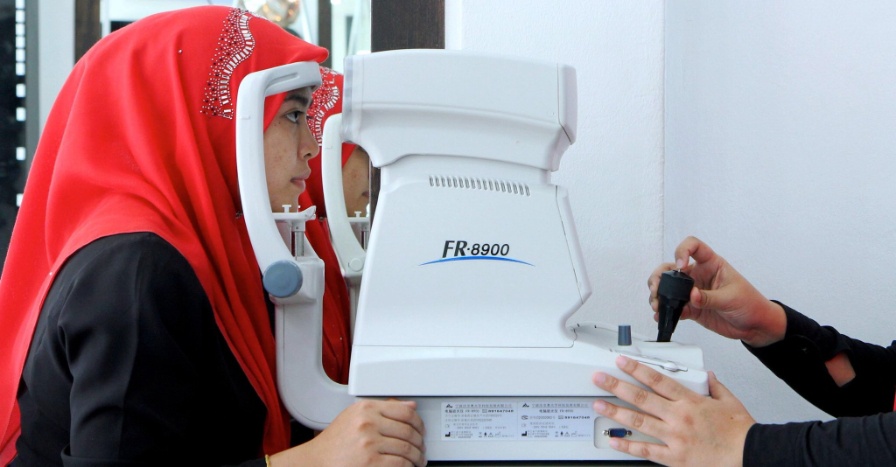KUALA LUMPUR (Bernama) — It is now more than two years since the COVID-19 pandemic upended our lives and disrupted our routines.
With the transition to endemic phase, Malaysians are slowly regaining normalcy in their day-to-day activities, with many returning to routine health checkups to ensure optimum health.
The work-from-home environment and social distancing during the Movement Control Order (MCO) caused increased use of digital devices, posing a greater risk of developing digital eye strain (DES)-related symptoms.
DES also known as computer vision syndrome, is a condition where a person experiences a temporary eye discomfort after prolonged use of electronic devices such as computer, tablet and mobile devices.
The level of discomfort increases with the amount of digital screen use. Symptoms include eye discomfort and fatigue as well as dry eyes, impaired vision and headaches.
BEWARE OF INCREASING SCREEN TIME RISK
Professional optometrist at MOG Eyewear Yoyo Foong told Bernama recently, eye examinations should be conducted regularly to ensure one’s vision stays healthy, noting that most eye-related diseases are also silent killers and will be untreatable if no swift action is taken.
She quoted a research conducted by the National Eye Survey Malaysia in 2018 which showed that of 15,000 individuals examined for blindness, 58.6 per cent of them were diagnosed with untreated cataracts that could have been prevented if they were detected earlier.
She believes the fewer breaks from screen time have contributed to a significant rise in the number of people with various vision-related issues during the COVID-19 pandemic.
“Generally, adults who may not have any vision-related issues should see an optometrist at least once every two years to upkeep vision health. However, since our screen time has drastically increased due to the pandemic that changes our lifestyle, we need to reconsider and prioritise our eye condition with a professional eye examination as often as once a year.
“Take notice of any minor eye discomfort or vision changes, such as having trouble distinguishing colours, needing time to adjust to changing levels of light, as well as losing the ability to see up close.
“Should you experience these warning signs, make an appointment for a thorough eye exam to receive appropriate treatment and rule out any serious conditions,” she said, noting that adults aged 18 and above are advised to undergo consultations with an optometrist once every two years for a comprehensive eye checkup.
COMMON PROBLEM OF AGEING EYES
Many people will not notice any signs or symptoms in the early stages of eye disease and they are mostly unaware that age is an influencing factor in eye condition and vision wellness. Age-related diseases such as age-related macular degeneration (AMD) may start to progress earlier during one’s lifespan, Yoyo warned.
She said three other known eye conditions that will start to rapidly develop as a person enters the golden age of 50 – 65 are diabetic retinopathy, cataracts and glaucoma. Those in this age group are advised to undergo regular checkups with their optometrist every year to maintain good eye condition.
“With a high risk of developing eye-related diseases at an older age, individuals with a family history or health condition that may potentially contribute to the above-mentioned eye diseases will need to begin their precautionary steps.
“If you are too busy for your eye checkups in a hospital or clinic, there is another option via a thorough eye and vision check-up with MOG’s 6-in-1 Vision Experience that revolves around a professional eye care routine which includes hospital-grade Eye Health Assessment.
“It can also address potential eye diseases through retina assessment that can detect any onset of Glaucoma, Diabetic Retinopathy and AMD, as well as corneal mapping and assessment for a detailed image of your eyeballs, which can reassure you of your current eye condition, and also detect the risk of cataract while sharing ways in which you can improve overall eye health,” she added.
REGULAR EYE CHECKUPS
Yoyo said eye health is important for the overall wellness of the body and should not be neglected.
“While the three Os (optometrists, ophthalmologists and opticians) can assist in detecting and preventing eye diseases, the ultimate responsibility lies with us to ensure our eyes are in good health.
“Caring for your eyes is not as complicated as it may seem and these are a few things you can do to protect your vision. You just have to eat a healthy and balanced diet, get regular exercises, wear sunglasses to protect from UVA/UVB radiation, avoid smoking, and also only buy contact lenses from reliable optical stores.
“Not only that, give your eyes a rest by using a 20-20-20 rule, in which for every 20 minutes spent looking at a gadget’s screen, try to look at something 20 feet away (6 metres) for 20 seconds. This can help to relax the accommodation reflex (reflex movement that occurs in the pupil) and reduces eye fatigue,” she said.
For those who are already a wearer of prescription glasses or contact lenses, it is advisable to schedule an eye examination to replace their vision aid at least once every two years.
“Just by checking your eyes, an optometrist is able to detect eye diseases as well as potential health risks and other underlying diseases such as cancer and diabetes, to name a few. Considering the benefits of eye examination to your well-being, it is best to include it in your annual health checkups.
“For those who are currently not using any vision aid, you may want to get a head start on eye health by scheduling an eye health assessment and comprehensive vision test with your local optometrist. The eye examination evaluates different aspects of your vision or eye health and helps to detect eye problems at their earliest stage when they are most treatable,” she added.
In addition, those working from home are advised to establish an ergonomically friendly work environment.
She said the optimal position of the monitor should be 15 to 20 degrees below eye level (about 4 or 5 inches) as measured from the centre of the screen and 20 to 28 inches from the eyes. Position the computer screen to avoid glare, particularly from overhead lighting or windows.
“Viewing on digital screen is more visually demanding as compared to traditional prints making us more susceptible to eyestrains, headaches, blurred vision, teary or dry eyes and neck/shoulder pain. It is advisable that individuals with perfect vision to use glasses prescribed for computer use to improve visual ability and comfort when working on digital screens to minimise harm to our eyes.
“Hence, establishing a proper working or reading distance which is an arm-length distance to help alleviate digital eye strain will work wonders too,” she added.
Sources: BERNAMA



